The winged nun of Ano Syros
by Lienke and Anke van Nugteren
Syros is a surprising island with the most wondrous stories, such as that of Sister Thérèse Mirzan, in the last century mother-superior of the Saint Sebastian convent in the medieval hill town of Ano Syros. A few years ago, a friend of ours in Brussels wished to explain the origin of their family name, Mirzan, to her grandchildren. To this purpose she researched her husband’s family tree. It led her to the discovery that his great-aunt, not all that many years ago, had been mother-superior of a monastic order on our island.
The history of this extraordinary lady begins long ago and far away from Syros, in the Persian Empire at the start of the 18th century. In the village of Koshekashene, situated in a Christian enclave of the province Nakhichevan (now Azerbaijian), there lived for centuries, the Armenian-catholic family Mirizan. The peaceful existence of this village ended when the territory was disputed by the Persian shah Nader and the Ottoman sultan Ahmed III.
Between 1710 and 1740, more and more Christians fled the violence of the warzone. In 1718, the priest of the Dominican parish of Khoshekashene also decided to leave for a safer place. Not only did he take the parishioners with him but also the centuries-old archives of his church. Needless to say that the statue of the Black Madonna could not be left behind. Under her protection, the shepherd and his flock undertook a journey of 1,500 kms through inhospitable landscapes. The statue, though damaged in the earthquake of 2020, is awaiting its restauration at the Saint Polycarp church in Izmir, formerly Smyrna.
The refugees started a new life in this prosperous port city. Over the next few centuries, the archives that had been safeguarded with so much effort, were enriched by an ever-growing list of birth, baptism, marriage, and death certificates of many generations of Mirizan, meanwhile transformed into Mirzan. In a large part, Smyrna owed its prosperity to these hardworking immigrants, who gave the city merchants, bankers and artisans. This prosperity ended abruptly on the 14th of September 1922 when the ‘Pearl of the Mediterranean’ was burnt to a cinder. But not everything was lost in the inferno.
Sœur Thérèse
In 2014, our friends in Brussels, Mr and Mrs Mirzan, travelled to Izmir. Meanwhile, Mrs Mirzan, also called Thérèse (pure coincidence), had found out that, during the outbreak of the fire, the priest of the Saint Polycarp parish had put the archives into safety in the neighbouring French consulate. These documents are now kept at the Centre des Archives Diplomatiques de Nantes. Of the utmost importance for our friend was the dossier Mirzan, série Constantinople, correspondance avec les échelles: Smyrne n° 47; a veritable open Sesame: a collection of texts in Armenian, written in 1784 by a descendant of the family Mirzan and translated into French by a Père Méchitariste in 1874. In those writings, she discovered the genealogy of the family Mirzan from the 16th century until 1784, based on the parochial registers of the Dominicans in Khoshekashene.
Back to Smyrna. On the 26th of December 1862, the priest on duty registered the birth of Marie Thérèse Catherine Mirzan, daughter of Laurent Polycarpe Mirzan and Uranie de Caravel. Already at a tender age, the girl felt drawn towards a life in the service of the poor and the needy.
She was a postulant (trial period at a convent edit.) with the Capuchin Order in Constantinople. She then stayed in Paris for six months, at the motherhouse of the Filles de la Charité de Saint Vincent-de-Paul. She joined this Order on the 12th of November 1892. She was sent to Scutari, on the Asian side of Constantinople. There, she taught Greek, Armenian and Turkish children for eight years. Mainly thanks to her linguistic skills (French, Greek and Turkish) she was transferred to Syros, as ‘Servant of the Poor.’. She came ashore on Syros on the 1st of August 1900, aged 38. At that age and with her experience, she was the ideal person to lead the Hôpital de Syra. This French institution was located high up in the Upper Town, in the shadow of the church of Ayios Yoryos. The mendicant Order to which Sister Thérèse belonged was already active in Santorini since 1841 and had established itself on Syros in 1884, upon the insistence of the local bishop. The Sisters had their work cut out for them. Sœur Thérèse occupied one of the pavilions surrounded by gardens behind the chapel of the Saint Sebastian parish. She took on the management of a busily frequented polyclinic. All islanders, including the poorest, were welcomed. She set up a home for the elderly and, for the little ones, many of them orphans, a crèche. The unit formed a self-sufficient village with kitchen gardens, its own well, soup kitchens, several refectories, and a home school. The hospital consisted of two floors with rooms for one, two or four patients.
Decay
Our Brussels friends came to Syros in May 2015. Mr Mirzan was always addressed in Greek because his Levantine roots are still so clearly recognisable. Together with a Syrianos friend, we played guide to our friends and led them though the labyrinth of the old town. We were used to the decrepit state of the former hospital and everything around it. Only the Saint Sebastian church is still in use and so is kept in good condition. A rusty forged iron fence right next to it gives access to an overgrown garden. In awe, we climbed the marble stairs leading to empty halls with gaping windows. Up the steps, through a corridor, down the steps, another corridor, more steps… Up and down, up and down, and this, year after year, at a fast pace by a no longer young Sister Thérèse. We could but hope that she could find some time to relax in the shade of an olive tree, with a view of the sparkling sea below. But look: in the garden, one level down, there are signs of life. The smell of baking and roasting is tantalising. The old soup kitchens still offer work and wholesome food to the less wealthy on the island, thanks to the catholic institution to Kastrí. Some years ago, the lady whose initiative this was, was honoured in Brussels with a prize from the European Commission. Thus, the past connects with the present.
The First World War
Back to the past: Sœur Thérèse was not only chiefly responsible for the hospital, she also dealt with the book-keeping and was a relentless fundraiser, as this is called nowadays. But her already burdensome task would grow even heavier. From April 1915 to June 1916, the Gallipoli campaign, so disastrous for the Allied Forces, cost 250.000 victims, on the Allied side as well as on the Turkish side. The sea strait of the Dardanelles was riddled with mines and became the hunting grounds of German submarines. The French minesweepers especially bore the brunt. Day and night, under constant artillery fire from the coast, the wounded were transported to the hospital ships in small vessels. As of the first weeks of the offensive, the exhausted crews of the French-Levantine expedition corps arrived on Syros. The weakest and the gravely wounded streamed into the Hôpital français. Many owed their lives to the good care of the Sisters. There were not enough surgeons for the operating theatre and not enough qualified staff for the infirmaries. Despite the extra workload, and amidst so much chaos and misery, Sœur Thérèse remained unflappable. She worked without pause. There are photographs and letters from that time. We can see her in her dark blue habit, under the snow-white wings of her starched veil, going from one sickbed to another. Often, she would stop next to one of these iron bedsteads and speak a word of encouragement. The patients said of her ‘she has cared for us as a mother’. The French consul who witnessed this wrote a report to his embassy in Athens: ‘France’s children were surrounded by love with the motherly care of the Sisters. Thanks to them, even the sickest of these men recovered their joy in life and were made to feel less homesick’. This report so impressed the French authorities that, years later, they would honour Sœur Thérèse with the Croix d’Argent de la Légion d’Honneur.
In the meantime, the war in the Aegean continued. In 1916, the hospital ship the Braemer Castle was hit by a mine. The surviving crew of the heavily damaged ship were transferred to the French hospital of Syros. In 1917, the transport ship Arcadian was torpedoed. The 30 victims of that disaster were washed ashore on the beaches of the different Cycladic islands. The Syra New British Cemetery has existed since 1921. On this spot, the 111 crew members, 30 marines amongst them, found their last resting place. Whenever we are near, we lay a flower on one of the graves in this cemetery, at the foot of Ano Syros. It is beautifully tended by the Commonwealth War Graves Commission. On most tombstones we read ‘A soldier of the Great War, known unto God’.
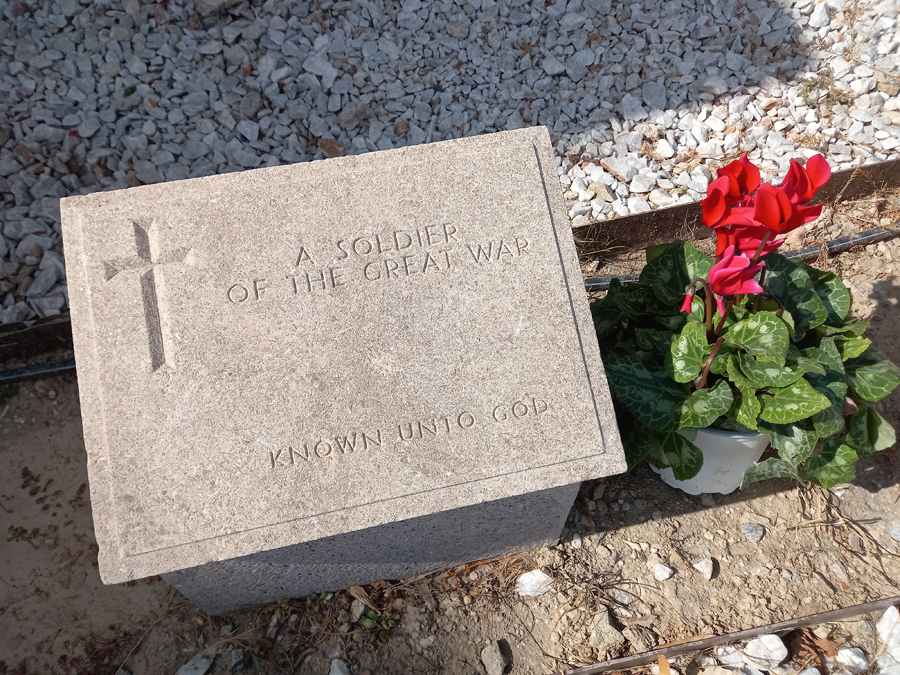
An anonymous grave in the Syra British Cemetery
1922
Even after 1918, the Sisters got little rest. The Asia Minor Catastrophe, with its umpteenth series of cruelty and misery, closely followed upon W.W.I. In September 1922, Smyrna was reduced to ashes. At the end of 1922, Thérèse took it upon herself to care for a growing number of orphans. Because, along with other islands and some towns on the mainland, Syros offered a safe haven for the refugees from Asia Minor. At the same time Thérèse tried to get as many family members as she could to Syros. With her help, these refugees were able to build a new life for themselves. But the woman who was held in such esteem by the French State tried in vain to obtain Greek citizenship. In 1922 she no longer was a subject of the Ottoman Empire. In 1938, in the run up to the Italian-German occupation of Syros, the then bishop of the island wrote yet another letter to the Prime Minister Ioánnis Metaxás asking him to grant her Greek nationality. Just one signature would suffice. But this request, too, remained unanswered.
The end
In June 1940, in her 78th year, the exhausted Sister transferred the management of the hospital and of the home for the elderly to Sister Anna Stamboulian. As a toddler, this Sister had survived the fire of Smyrna and had already been working on Syros for years. We were supposed to visit her in May 2014, at the new address of the home for the elderly of the Sœurs de la Charité de Saint-Vincent-de-Paul. This building, magnificently restored thanks to the funds of the Niarchos Institute, is located in the Vaporia neighbourhood, in downtown Ermoúpolis. We were welcomed by Sister Lucie, in a reception room with gilded mirrors and and red velvet curtains. After coffee, we found ourselves on what must be the most beautiful terrace of the city, with an unimpeded view of the turquoise sea. One would almost wish to be sufficiently old and rich to afford a room here! Unfortunately, that morning, the already extremely ancient Sister Stamboulian was too confused to receive visitors. Yet Sister Lucie was game for another attempt. Armed with a picture of the nuns in the garden of the Saint Sebastian Convent she hurried to Sœur Stamboulian’s room. A little later, she announced, visibly pleased, that the Sister had immediately recognised her superior, exclaiming: Mais c’est ma Sœur Thérèse de la Haute Ville! From the cheerful Sœur Lucie we heard the following anecdote, delivered in her Levantine accented French: ‘One of our sisters managed to get aboard a warship that was anchored in the bay of Smyrna. Chaos reigned on deck, with people pushing and shoving in their panic. An open hatch almost proved fatal. One wrong step and she tumbled into the hold, all the way to her neck. She was saved by the starched wings of her veil. Helping hands pulled her out. Vous vous imaginez?’ Yes, we could imagine, and murmured with Sœur Lucie ‘God be praised!’
On the 28th of January 1956, after a long illness, Sœur Thérèse died at the convent of Saint Sebastian, in her beloved Ano Syros. She received a grand funeral. But in the catholic cemetery there is no trace of her last resting place: as mendicant Sister she remains humble and unremarkable after such a deserving and remarkable life.
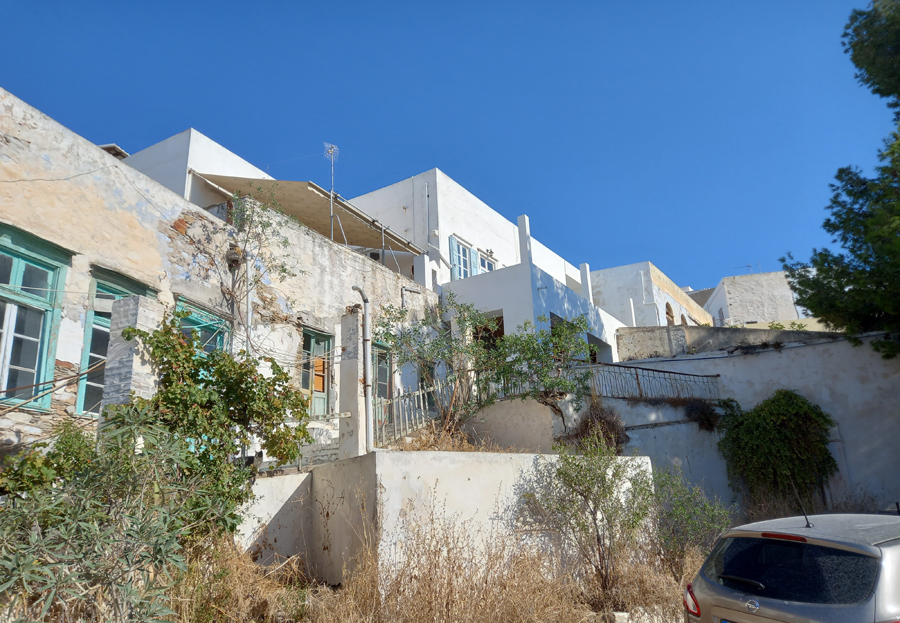
This is what is left of the French Hospital of Syros
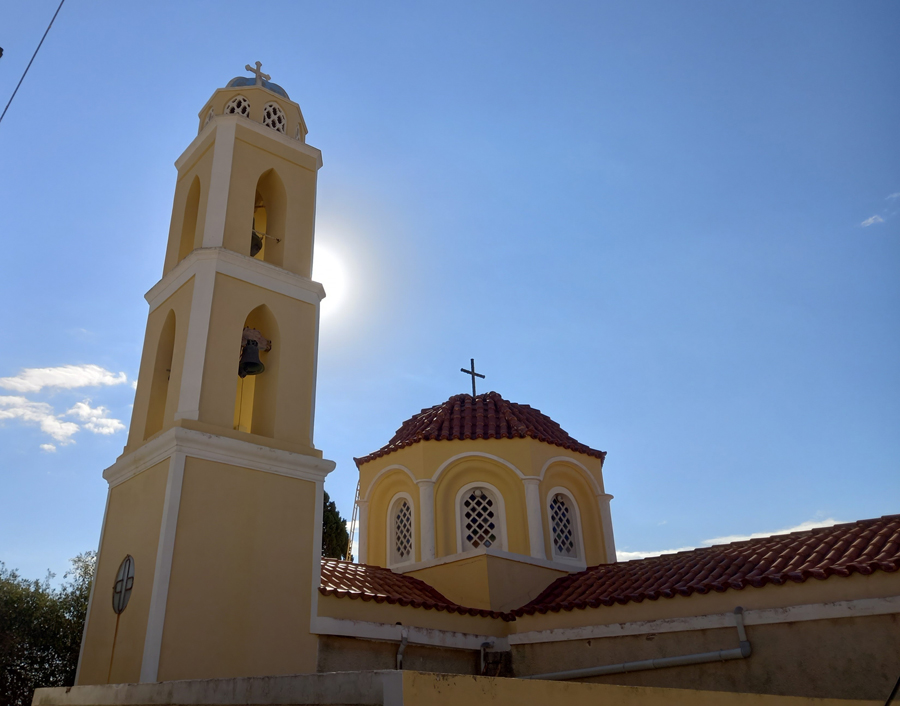
Saint Sebastian church
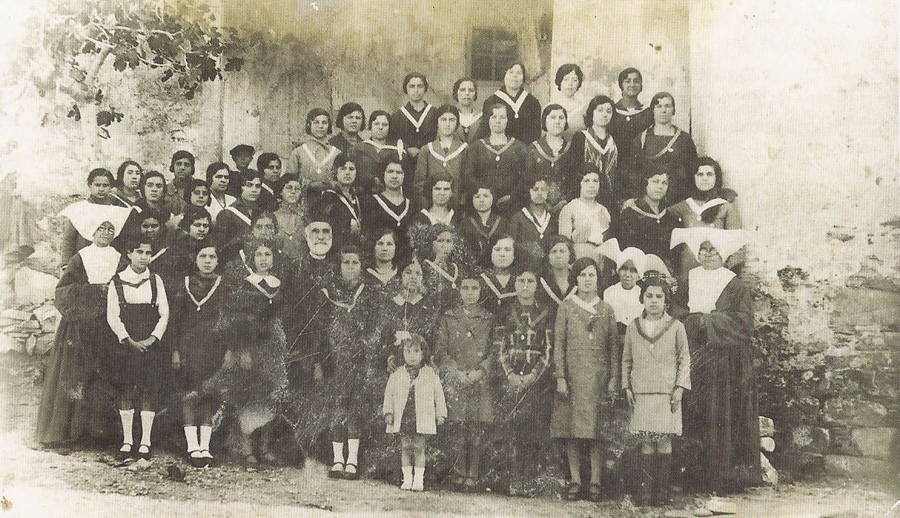
caption from Greek: “Children of the Virgin” in 1925 with the confessor Don Nikiphoros Vartaliti and with Sister Th. Mirzan [to the left] and Sister E. Angelvin.
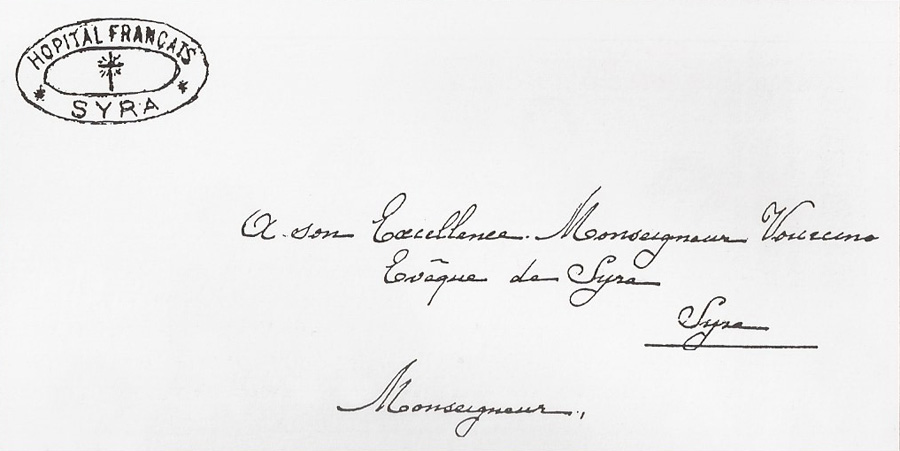
copy of Sœur Thérèse’s handwriting
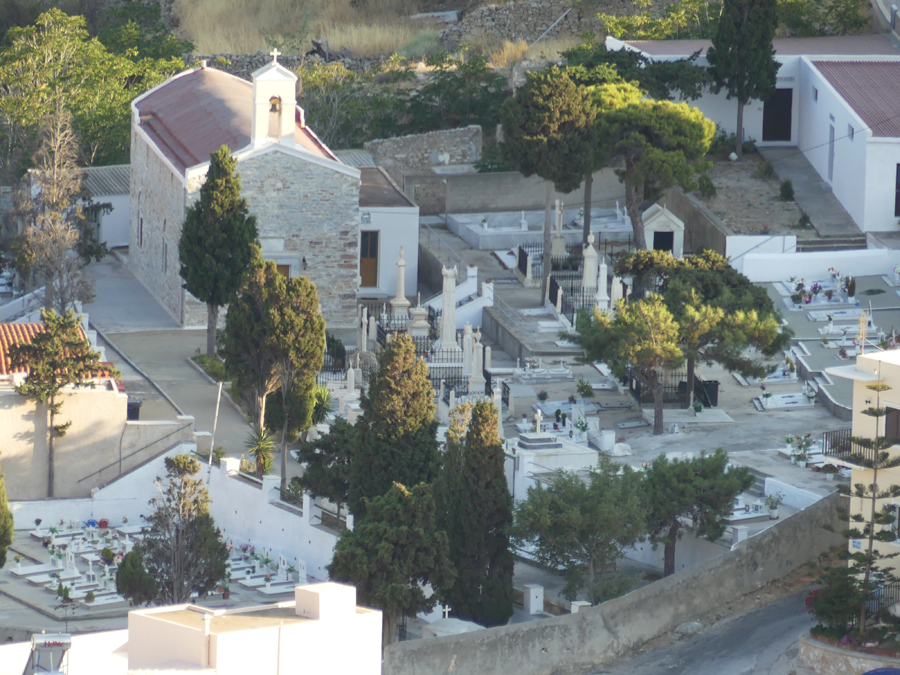
The cemetery of “Our Lady of Mount Carmel”, the catholic cemetery of Syros where Sœur Thérèse’s remains are “hidden”.
The expanded article in Dutch in the publication ‘Lychnari’, dedicated to ‘Explorations in Greece today’ winter 2022 edition.